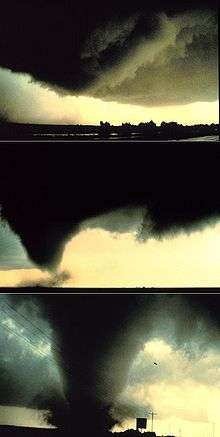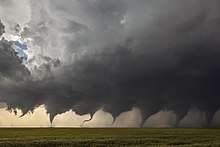Tornadogenesis


Tornadogenesis is the process by which a tornado forms. There are many types of tornadoes, and each type of tornado can have several different methods of formation. Despite ongoing scientific study and high-profile research projects such as VORTEX, many of the mechanisms of tornado formation are still poorly understood.
Supercellular tornadoes
Classical tornadoes are supercellular tornadoes, which have a recognizable pattern of formation.[1] The cycle begins when a strong thunderstorm develops a rotating mesocyclone a few miles up in the atmosphere. As rainfall in the storm increases, it drags with it an area of quickly descending air known as the rear flank downdraft (RFD). This downdraft accelerates as it approaches the ground, and drags the rotating mesocyclone towards the ground with it. Storm relative helicity (SRH) has been shown to play a role in tornado development and strength. SRH is horizontal vorticity that is parallel to the Inflow of the storm and is tilted upwards when it is taken up by the updraft, thus creating vertical vorticity.
As the mesocyclone lowers below the cloud base, it begins to take in cool, moist air from the downdraft region of the storm. This convergence of warm air in the updraft, and this cool air, causes a rotating wall cloud to form. The RFD also focuses the mesocyclone's base, causing it to siphon air from a smaller and smaller area on the ground. As the updraft intensifies, it creates an area of low pressure at the surface. This pulls the focused mesocyclone down, in the form of a visible condensation funnel. As the funnel descends, the RFD also reaches the ground, creating a gust front that can cause severe damage a good distance from the tornado. Usually, the funnel cloud begins causing damage on the ground (becoming a tornado) within a few minutes of the RFD reaching the ground.
Field studies have shown that in order for a supercell to produce a tornado the RFD needs to be no more than a few Kelvin cooler than the updraft. Also the FFD (Forward Flank Downdraft) seems to be warmer within tornadic supercells than it is the case in non-tornadic supercells.
Waterspouts
Waterspouts are defined as tornadoes over water. However, while some waterspouts are supercellular (also known as "tornadic waterspouts"), forming in a process similar to that of their land-based counterparts, most are much weaker and caused by different processes of atmospheric dynamics. They normally develop in moisture-laden environments with little vertical wind shear in areas where wind comes together (convergence), such as land breezes, lake effect bands, lines of frictional convergence from nearby landmasses, or surface troughs. Waterspouts normally develop as their parent clouds are in the process of development. It is theorized that they spin upward as they move up the surface boundary from the horizontal shear near the surface, and then stretch upward to the cloud once the low level shear vortex aligns with a developing cumulus or thunderstorm.[2] Their parent cloud can be as innocuous as a moderate cumulus, or as significant as a supercell.
Landspouts
Landspouts are tornadoes that do not form from supercells and are similar in appearance and structure to fair-weather waterspouts with the exception that they form over land instead of water. They are thought to form in a manner similar to that of weaker waterspouts[3] in that they form during the growth stage of convective clouds by the ingestion and tightening of boundary layer vorticity by the cumuliform tower's updraft.
Continuing research
Though these are widely accepted hypotheses for how most tornadoes form, they do not explain the formation of long-lived tornadoes, or tornadoes with multiple vortices. These each have different mechanisms which influence their development—however, most tornadoes follow a pattern similar to these ones.[4] There are still many aspects about the formation of tornadoes which remain a mystery.[5] Research programs, including VORTEX, deployment of TOTO (the TOtable Tornado Observatory), and dozens of other programs, hope to solve many questions that still plague meteorologists about this topic.[6]
See also
References
- ↑ Doswell, Moller, Anderson; et al. (2005). "Advanced Spotters' Field Guide" (PDF). US Department of Commerce. Archived from the original (PDF) on 2006-08-23. Retrieved 2006-09-20. External link in
|publisher=(help) - ↑ Barry K. Choy and Scott M. Spratt. Using the WSR-88D to Predict East Central Florida Waterspouts. Retrieved on 2006-10-25.
- ↑ National Weather Service (June 30, 2017). EF-0 Landspout Tornado near Grand Junction, MI on June 30, 2017 https://www.weather.gov/grr/summary20170630. Retrieved 20 March 2018. Missing or empty
|title=(help) - ↑ Markowski, Paul M.; J.M. Straka; E.N. Rasmussen (March 2003). "Tornadogenesis Resulting from the Transport of Circulation by a Downdraft: Idealized Numerical Simulations". J. Atmos. Sci. 60 (6): 795–823. Bibcode:2003JAtS...60..795M. doi:10.1175/1520-0469(2003)060<0795:TRFTTO>2.0.CO;2.
- ↑ "VORTEX: Unraveling the Secrets." National Severe Storms Laboratory.
- ↑ Rasmussen, Erik (31 December 2000). "Tornado Forecasting". Archived from the original on 19 September 2004. Retrieved 2000-11-04. Check date values in:
|accessdate=(help)
Further reading
- Markowski, Paul M.; Y.P. Richardson (Jul 2009). "Tornadogenesis: Our current understanding, forecasting considerations, and questions to guide future research" (PDF). Atmos. Res. 93 (1–3): 3–10. Bibcode:2009AtmRe..93....3M. doi:10.1016/j.atmosres.2008.09.015.
External links
- Markowski, Paul; Y. Richardson (2014). "What We Know and Don't Know About Tornado Formation". Phys. Today. 67 (9): 26–31. Bibcode:2014PhT....67i..26M. doi:10.1063/PT.3.2514.
- Markowski, Paul; Yvette Richardson (July–August 2013). "How to Make a Tornado" (PDF). Weatherwise: 12–19.
- Tornadogenesis in Supercells: The Three Main Ingredients (NWS)
- Rasmussen, Erik; J. Straka; K. Kanak; et al. (2009). "Tornadogenesis: Unknowns. What's Left to Learn About Tornadoes?" (ppt). Rasmussen Systems. Retrieved 2012-02-14.
- Tornadogenesis research by Erik Rasmussen et al and Paul Markowski et al, also Josh Wurman et al